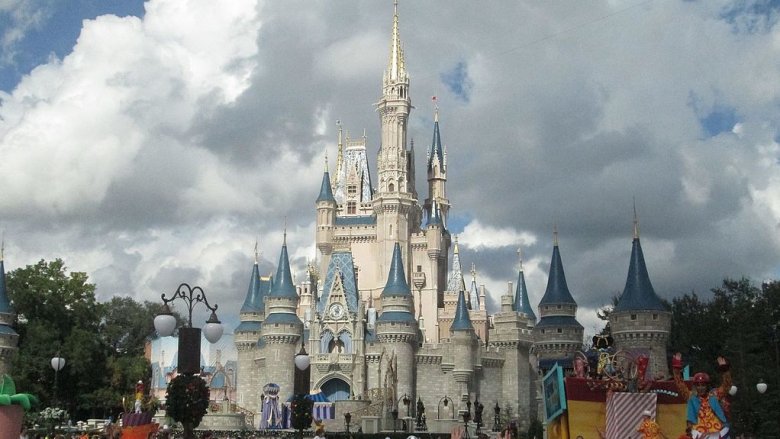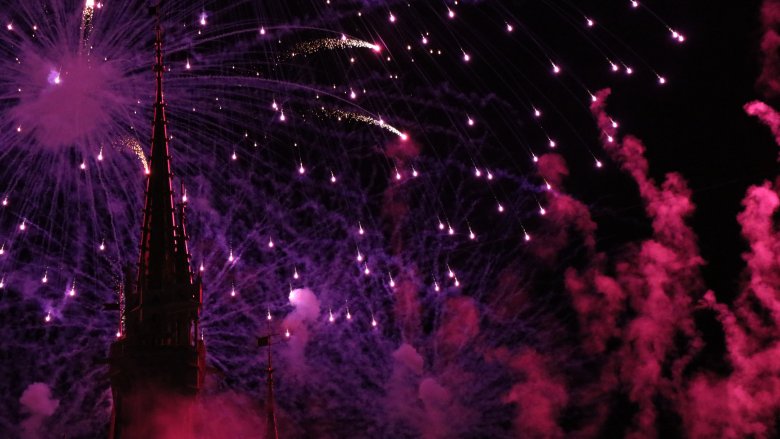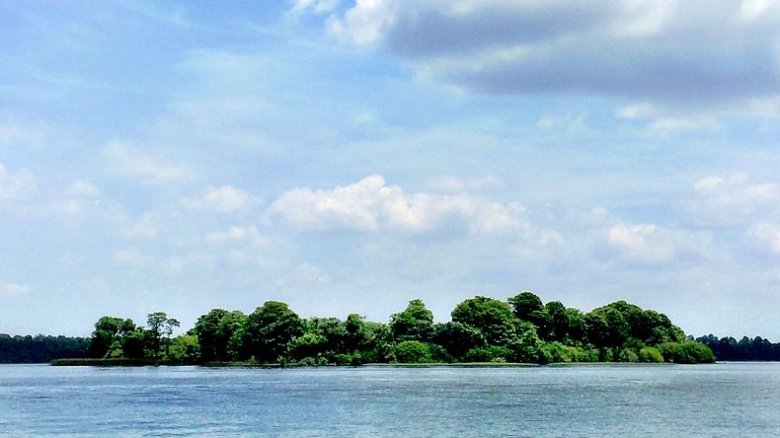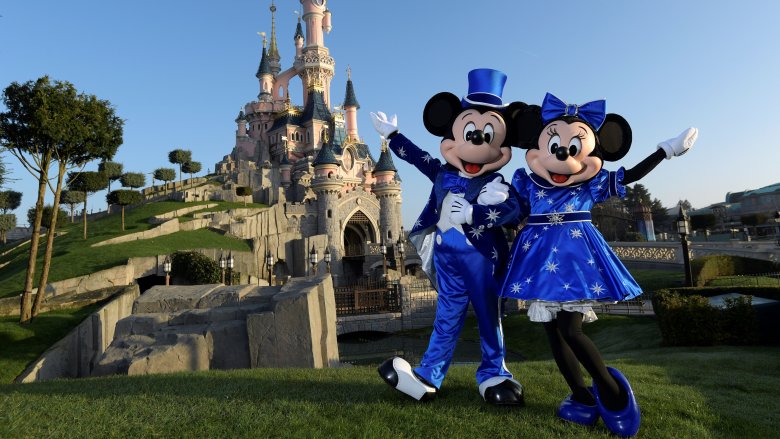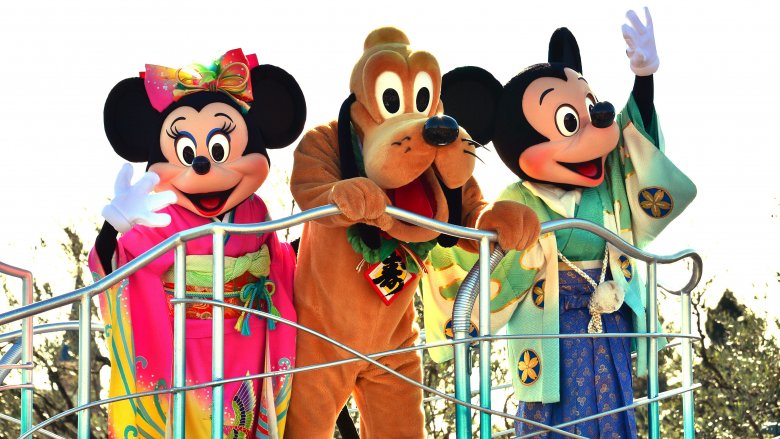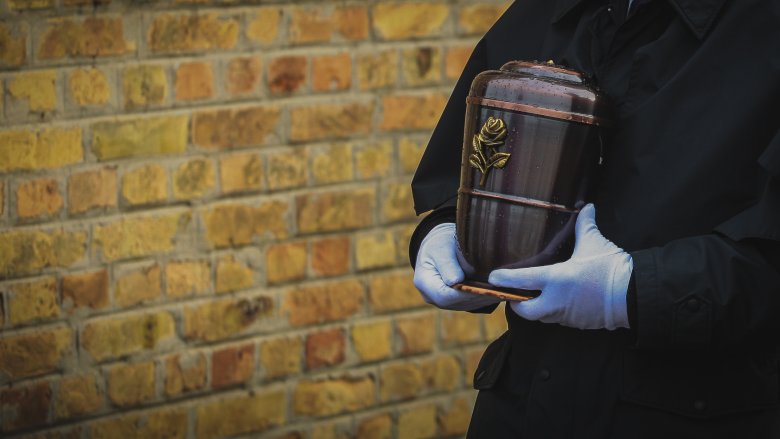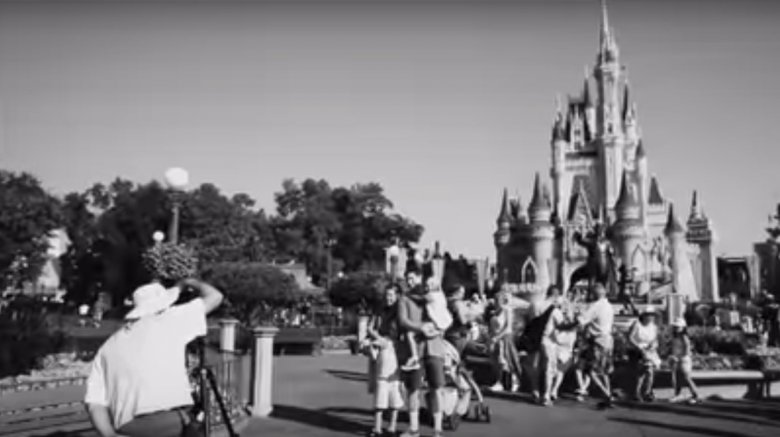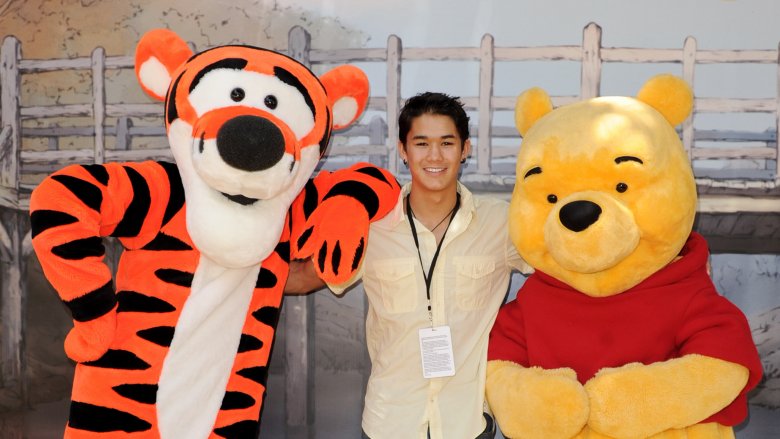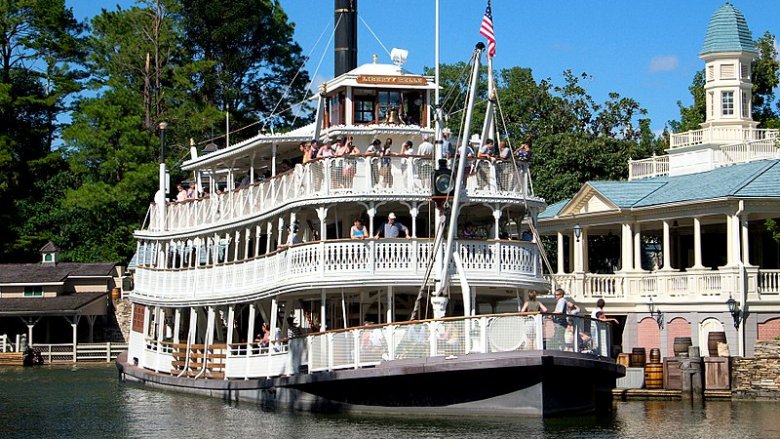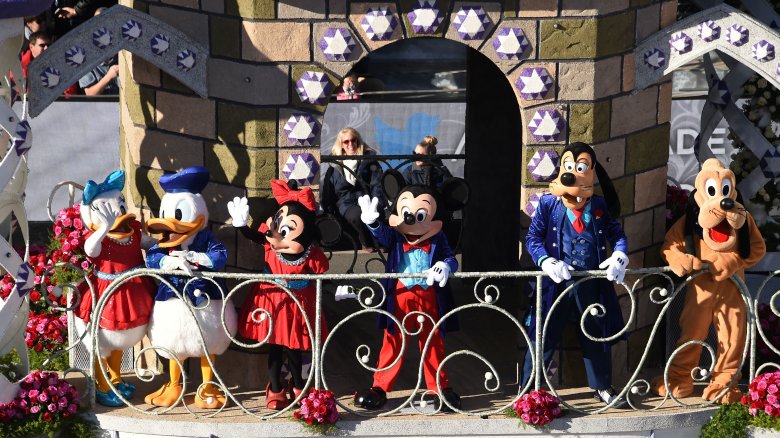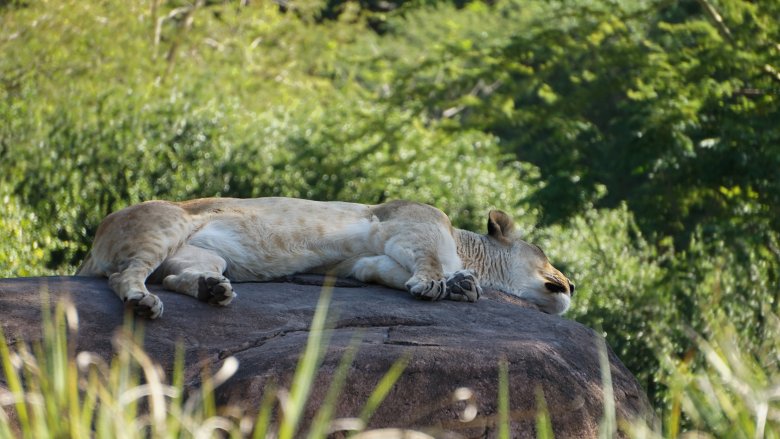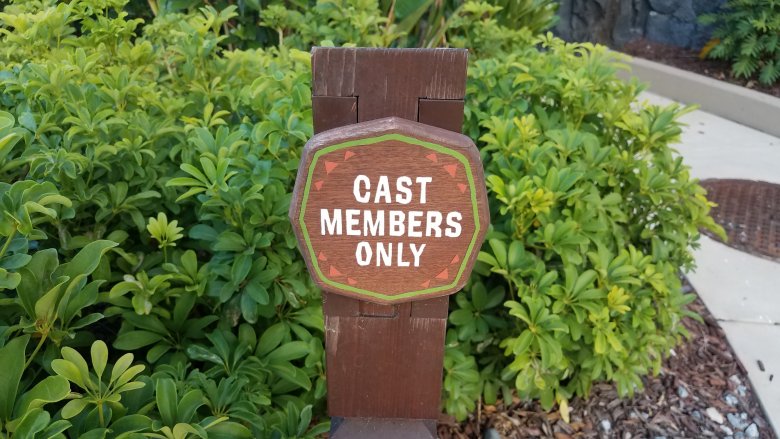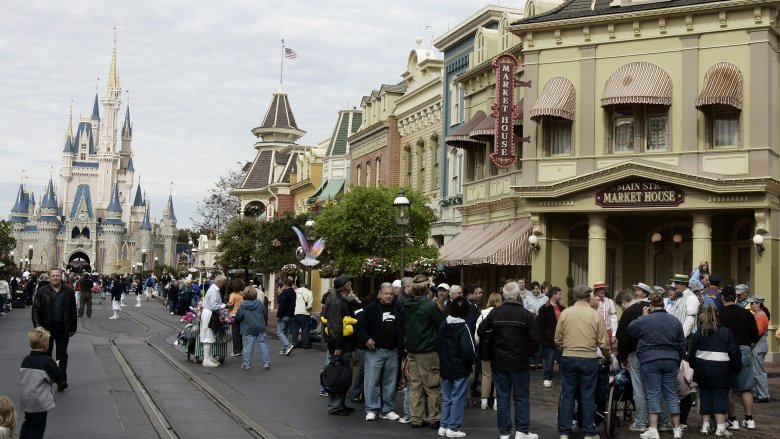Secrets Disney World Doesn't Want You To Know
Disney World is the happiest place on Earth, and Disney would like to keep it that way, thank you very much. So you're not likely to find any of the following facts listed in a travel brochure or on Disney's website, right between "Star Wars: Galaxy's Edge" and "Here's how broke you will be after you take your family of four to Disney World for three days."
No, Disney doesn't want you to know how miserable their employees are, or how many people have died at the park, or what little tricks they use to maintain the whole "happy place" fantasy. We have the insider info, though. So if you're lamenting the fact that you have to be fabulously wealthy or become fabulously indebted in order to enjoy a Disney vacation, perhaps this collection of Disney World's deepest, darkest secrets will at least make you feel a little better about choosing a beach vacation instead.
People have died there
You sometimes hear about people dying on fairground rides or in freak horse-drawn carriage accidents, but at Disney World? No. If people died at Disney World they couldn't call it "the happiest place on Earth" anymore, could they?
Well as it turns out, accident statistics don't appear to have any bearing on whether a company gets to maintain its stupid slogans. People have, indeed, died at Disney World, and sometimes in horrible, horrible ways. We're not going to linger on the 2-year-old who was killed by an alligator at Disney World because that's just too awful to contemplate. According to Mic, there have been several other guest fatalities, including a 9-year-old who was killed by a shuttle bus and a man who was killed when he was struck by a derailed train car on the Big Thunder Railroad. Employees have died, too — in 2004 a man dressed as Pluto was killed by a float, and in 1974 an 18-year-old employee was killed by the moving wall of a rotating stage.
Happy? For the vast majority of guests, yes, except of course the parents whose kids are having a meltdown because they ate too much junk food and Mickey Mouse is super scary in real life. But even so, it's smart to be aware of your surroundings because there's no such thing as a 100% safe travel destination, no matter how "happy" it claims to be.
There's an abandoned theme park on an island in Disney World's Bay Lake
Those photos of the abandoned amusement park near Chernobyl are some of the most haunting images you'll ever see — but did you know that Disney World has its own creepy abandoned amusement park, too? Its circumstances aren't quite as harrowing, but it's still one of those things that Disney wishes would just go away and stay buried.
According to the Plaid Zebra, for nearly 25 years, visitors to Disney's Discovery Island enjoyed a wildlife preserve slash amusement park that housed more than 600 native and tropical birds and featured a walk-in aviary, a flamingo pool, and bird shows. But alas, Disney was unable to protect its feathered cast members from real-life villains. In 1989, word got out that people were shooting rifles at the resident hawks and beating vultures to death, and that employees were destroying the nests and eggs of ibises and egrets. Authorities launched an investigation and charged Disney with 16 state and federal counts of bird abuse. Disney settled the matter out of court for $95,000.
Discovery Island limped along for another decade, but it finally closed its doors in 1999. The ruins of the old park are still there, though — but to get there you have to either take a boat (not allowed) or swim through alligator-infested waters (also not allowed, but who's going to do that anyway). So most of the island's remaining secrets will likely stay untold.
It sucks being a costumed character
Let's say you do decide to drop your life savings on a three-day Disney World vacation — don't forget that those hard-working costumed performers who are making your kids' eyes light up with wonder are underpaid and really, really hot and sweaty.
In Disney jargon, performers covered from head to toe are called "fur characters," while princesses and the like are "face characters." According to Disney Fanatic, fur costumes are hot even during the off season, when it isn't a million degrees outside with humidity at 720%. And the costumes are heavy, too — they can weigh up to 47 pounds, which means the cast members have to have a lot of physical endurance in order to do their jobs well. Fortunately, fur characters aren't walking around in those costumes all day, or probably several hundred of them would be on the list of park fatalities. When the weather is below 94 degrees, they work 30 minutes on, 30 minutes off. On especially hot days they get 20-minute shifts.
Still, Disney Fanatic notes that "virtually all [fur characters] emerge from their costumes at the end of the shift as a disheveled, soaking wet mess." And they don't get paid a whole lot for what they do, either. Glassdoor says the average base pay for a Disney Parks & Resorts character performer is $11 an hour.
Why it extra-sucks to be a costumed character (or any cast member)
Okay, so you're bringing magic to kids, what could be better than that? As a costumed character, you must be showered with love all day long, right?
Not exactly. Now, you certainly do get love and appreciation from most of the guests, but Disney employees also report an awful lot of abuse at the hands of park visitors. According to Mental Floss, guests will sometimes punch, push, or over-hug the costumed characters. The website says there were 773 cast member injuries reported in 2005, and roughly 14 percent of them were caused by guests' aggressive behavior. In 2013, a 24-year-old man was arrested after he punched two male cast members in the face and hit a female cast member with a PVC pipe.
And just to make matters worse, employees don't get the same perks you might expect if you were working at like pretty much any other place that serves the public. Former cast member Meghan O'Neill told Business Insider that there are no free passes for Disney employees. "When we are not working, we're just regular guests," she said. Well, that sucks.
When I die, spread my ashes at Disney World
If you're ever tempted to speak those words to your loved ones, don't. Asking to be interred at Disney World is placing a terrible burden on your family. Because Disney World strictly does not allow such things, and also, the family member who gets coerced into being the ash-spreader will get a lifetime ban from all Disney Parks. Also, the crew at Disney World will sweep up your ashes and put them in a dumpster, which probably is not how you wanted to spend eternity.
According to Disney Fanatic, this happens frequently enough that Disney cast members have a code phrase for it: "white powder alert" or sometimes "Code Grandma." Guests who attempt to spread someone's ashes in the park are always going to get caught because there are cameras everywhere. It's not a harmless crime, either. (And it is actually a crime.) When it happens (usually around once a month), the park has to shut down whatever ride it happened on, and cast members must don protective clothing and vacuum up the mess. Then, Grandma goes to the landfill. So just don't. If you must have a Disney burial, you could always get a tombstone with mouse ears.
Someone made a horror film in the park without getting Disney's permission
In this true story that is even more bizarre than a live-action version of Aladdin (Why? Just why?), a film crew shot an entire movie inside Disney World without permission. The film was the brainchild of Randy Moore, who IndieWire says has "both happy and horrific" memories of visiting the park as a child with his heavy-drinking dad. Moore later said the experience was so stressful that he lost 47 pounds during the year they spent shooting the film.
Weirdly, Moore's use of Disney World as an unauthorized set for his dark comedy/horror film Escape from Tomorrow falls under the umbrella of fair use, so although Disney certainly wouldn't have allowed him to shoot there if they'd known what he was doing, there doesn't seem to be anything they can do about it after the fact. "Under copyright law, commentary and parody are well-established fair-use categories," wrote Columbia Law School professor Tim Wu. "[Moore's] use of Disney World is not as simple window dressing; he transforms it into something gruesome and disturbing." So the fact that Moore portrayed the happiest place on Earth as the most awful place on Earth actually helped make the whole endeavor (probably) legal. Wow, Disney must be so pissed.
Characters behaving badly
Disney fur characters are fun for the kids, and the vast majority of them have the best intentions. They do what they do not for the $11 an hour and because they enjoy a free sweat bath, but because they love to bring happiness to park visitors.
In every job, though, there are a few bad eggs. According to NBC Philadelphia, some Disney guests have complained of getting groped by characters, including a woman who says Donald Duck fondled her — she settled out of court for an undisclosed amount.
At least Donald's transgression was isolated though (or so it seems). Another Walt Disney World employee was also accused of inappropriately touching guests while dressed as Tigger — in fact authorities got more than 24 complaints about Tigger following the initial report, though the actor was eventually acquitted of the most serious charge. His attorney argued that fully costumed characters have limited vision and mobility while in their outfits, which makes it easy for inappropriate touching to happen accidentally.
Those boats don't really float
Surely no one over the age of, say, 12 thinks that actual magic happens at Disney World. We adults at least understand that it's all just an elaborate illusion, but it might surprise you to hear about some of the tricks Disney has to pull to maintain the fantasy.
Disney World features a number of "boat" rides, and you probably won't be especially shocked to hear that the "boats" aren't actual boats — they're on tracks, just like all of the other rides. So how does Disney pull off this particular illusion? With dye.
The Liberty Belle is the paddlewheel steamship that runs on a "river" around Tom Sawyer Island, but according to World of Mouse, it needs no captain because it never leaves the track that's hidden just under the surface of the water. To maintain the illusion, the water in the river is dyed green and brown, so guests can't see the track. In fact the boat needs just 18 inches of water depth as it proceeds along the track. It's a pretty convincing illusion, though, right?
In 2017 Disney owed nearly $4 million in back wages
It's bad enough being an underpaid fur character on a 110-degree day in Florida and occasionally being accused of uncouth behavior, but to add insult to injury, in 2017 a judge found that 16,339 Disney employees were owed back wages because Disney was deducting costume or uniform expenses from their paychecks. At the time, that was enough to slip many employees under the threshold for the federal minimum wage. Wow, Disney.
According to Fortune, Disney owed a total of $3.8 million to affected employees. And that's not their only transgression — the Department of Labor found that they didn't keep their payroll records up to date and also didn't pay some of their employees for working overtime.
In Disney's defense, everyone else does it, too. The district director for the Wage and Hour Division in Jacksonville, Florida, said those sorts of employment violations were "not uncommon," and that Disney was "very cooperative" during the investigation. And don't have to feel too bad about that big dollar amount, either — in 2014, Disney's domestic parks and resorts had a total operating profit of $2.7 billion, so it's not like those back wages are going to sting all that much.
The Kilimanjaro Safaris animals are bribed
Visitors to Disney World get to experience something that Disneyland suckers ... err, treasured guests ... don't. The Kilimanjaro Safaris opened in 1998, and it was the realization of one of Walt Disney's dreams — to exploit actual, live animals for the amusement of park visitors.
Unlike the Jungle Cruise, which entertains visitors with animatronic animals and seriously cringeworthy puns, Kilimanjaro Safaris features more than 30 species of African wildlife, including lions, cheetahs, wild dogs, zebras, elephants, and giraffes. According to The Mouse for Less, the Kilimanjaro savannah is 110 acres — 5 full acres larger than the entire Magic Kingdom. But because the place is so enormous, Disney has to employ some tricks to keep the animals from retreating to the farthest corners of the land in order to avoid being gawked at. For example, air-conditioned rocks entice the animals to choose visible resting areas, and there are also strategically placed cool breezes and cooling or warming waters close to where the ride's vehicles will pass.
Staff will use food to bring the animals closer, too — a raisin cannon helps attract the gorillas, and honey is smeared on some surfaces to bring in the elephants. So you see, kids, bribery is a useful tool for getting exploited creatures to do what you want them to. Now go home and try that out on your siblings.
Employees get around through secret tunnels under the park
Secret tunnels and hidden passageways ... it's all part of the Haunted Mansion, right? Actually, everything at Disney World — not just the iconic mansion — is basically the second floor because the entire park is built over an elaborate system of tunnels.
Oooh that sounds super cool and mysterious, but according to Business Insider the tunnels themselves are pretty anticlimactic even despite the whole "secret" and "underground" aspect of them. The tunnels are officially known as "utilidors," and because Florida is basically a nasty, flat swamp they were actually built at ground level, with the rest of the park on top at roughly 14 feet above ground level.
Mike Fox, who wrote a book called The Hidden Secrets & Stories of Walt Disney World noted that the tunnels are essentially just a smart business tool because they allow cast members to move between the park's different lands without appearing out of place. You wouldn't want Chewbacca, for example, to walk through Frontierland because that would be weird.
Employees also have access to underground cafeterias, dressing rooms, and even a hair salon. So it's kind of like a little village beneath the Magic Kingdom, that no one without a name tag will ever get to see.
Smellitizers
Oh the things that Disney has contributed to modern technology. Animatronics. Digital sound. 4-D movies. Smellitizers. Wait, what?
Yes, the smellitzer. If you have been to any of Disney's theme parks, you might not have even noticed their copious use of these things. Their most obvious application is on certain rides, like Soarin' Around the World, where you can literally smell the flowers and the great outdoors. While standing in line for Pirates of the Caribbean you might notice the scent of salty sea air.
But Disney also uses smellitizers for more insidious purposes. According to Walt Disney World for Grown Ups, Main Street USA uses smellitizers to pipe in the smells of cookies and candies, so you'll maybe think to yourself, "You know what would be great right now? Cookies! Or maybe candy." In other words, the smells are designed to entice you and make you part with your money. Because it's not enough that you spent an entire month's salary taking your kids there for three days, and that's without factoring in food and snacks. Happiest. Place. On. Earth.
